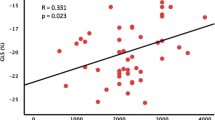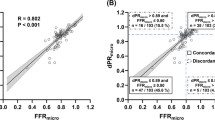Abstract
Background
Although only high-flow arteriovenous fistulas (AVFs) are postulated to cause high-output cardiac failure (HOCF), there are currently no universally accepted criteria defining a high-flow fistula.
Methods
To verify if vascular access blood flow (Qa) ≥ 2000 ml/min provides an accurate definition of high-flow fistula, we selected 29 consecutive patients with Qa ≥ 2000 ml/min at color-duplex ultrasound examination and assessed them for the presence of cardiac failure symptoms; transthoracic echocardiography was also performed.
Results
Nineteen patients (65%) had heart failure symptoms and were classified with HOCF. At receiver operating characteristic (ROC) curve analysis, Qa ml/min values did not identify patients with heart failure symptoms but when AVF blood flow was indexed for height2.7, Qa ≥ 603 ml/min/m2.7 detected the occurrence of HOCF with good accuracy (sensitivity 100%, specificity 60%, efficiency 86%, positive predictive value 83%, negative predictive value 100%, area under curve 0.75). At echocardiographic evaluation, patients with Qa ≥ 603 ml/min/m2.7 had a more severe increase of left ventricular mass (63 ± 18 vs. 47 ± 7 g/m2.7, p < 0.003), left ventricular diastolic volume (140 ± 42 vs. 109 ± 14 ml, p < 0.007), left atrial volume (53 ± 23 vs. 39 ± 5 ml/m2, p < 0.015), a higher incidence of diastolic dysfunction (70 vs. 17%, p < 0.019) and higher CO reduction after AVF manual compression (2151 ± 875 vs. 1292 ± 527 ml/min, p < 0.009) than patients with Qa < 603 ml/min/m2.7.
Conclusions
Indexation of AVF blood flow should be considered in defining high-flow fistula because the effect of Qa may differ in individuals of different sizes. A Qa value ≥ 603 ml/min/m2.7 and its association with some echocardiographic alterations could identify patients at higher risk for HOCF.



Similar content being viewed by others
References
Bradbury BD, Fissell RB, Albert JM et al (2007) Predictors of early mortality among incident US hemodialysis patients in the dialysis outcomes and practice patterns study (DOPPS). Clin J Am Soc Nephrol 2(1):89–99
Mauri JM, Vela E, Clèries M (2008) Development of a predictive model for early death in diabetic patients entering hemodialysis: a population-based study. Acta Diabetol 45(4):203–209
US Renal Data System. USRDS 2012 annual data report: atlas of chronic kidney disease and end-stage renal disease in the United States. National Institute of Diabetes and Digestive and Kidney Diseases, Bethesda 2012
Amerling R, Ronco C, Kuhlmann M, Winchester JF (2011) Arteriovenous fistula toxicity Blood Purif 31:113–120
Beathard GA. Heart failure and hemodialysis arteriovenous fistulae. http://www.uptodate.com © 2017 UpToDate. Accessed May 22, 2017
Ahearn D, Maher J (1972) Heart failure as a complication of hemodialysis arteriovenous fistula. Ann Intern Med 77:201–204
Anderson C, Codd J, Graff R, Groce M, Harter H, Newton W (1976) Cardiac failure and upper extremity arteriovenous dialysis fistulas. Case reports and a review of the literature. Arch Intern Med 136:292–297
Bailey WB, Talley JD (2000) High-output cardiac failure related to hemodialysis arteriovenous fistula. J Ark Med Soc 96:340–341
Engelberts I, Tordoir JH, Boon ES, Schreij G (1995) High-output cardiac failure due to excessive shunting in a hemodialysis access fistula: an easily overlooked diagnosis. Am J Nephrol 15:323–326
Murray BM, Rajczak S, Herman A, Leary D (2004) Effect of surgical banding of a high-flow fistula on access flow and cardiac output: intraoperative and longterm measurements. Am J Kidney Dis 44:1090–1096
Trespalacios F, Taylor A, Agodoa L, Bakris G, Abbott K (2003) Heart failure as a cause for hospitalization in chronic dialysis patients. Am J Kidney Dis 241:1267–1277
VanderWerf B, Kumar S, Pennell P, Gotlieb S (1978) Cardiac failure from bovine graft arteriovenous fistula: diagnosis and management. Trans Am Soc Artif Intern Organs 24:474–475
Young P, Rohr M, Marterre W (1998) High output cardiac failure secondary to a brachiocephalic arteriovenous hemodialysis fistula: two cases. Am Surg 64:239–241
MacRae J, Pandeya S, Humen D, Krivitski N, Lindsay R (2004) Arteriovenous fistula-associated high-output cardiac failure: a review of mechanisms. Am J Kidney Dis 43:E17–E22
London GM (2002) Left ventricular alterations and end-stage renal disease. Nephrol Dial Transpl 17(Suppl 1):29–36
Ohira S, Naito H, Amano I et al (2006) 2005 Japanese Society for dialysis therapy guidelines for vascular access construction and repair for chronic hemodialysis. Ther Apher Dial 10(5):449–462
NKF-K/DOQI Clinical Practice Guidelines For Vascular Access. Am J Kidney Dis 2006; 48(Suppl 1): S176-S273
EBPG on Vascular Access. Nephrol Dial Transplant 2007; 22 [Suppl 2]: ii88–ii117
The Society for Vascular Surgery: Clinical practice guidelines for the surgical placement and maintenance of arteriovenous hemodialysis access. J Vasc Surg 2008; 48: 2S-25S
Renal Association Clinical Practice Guideline on Vascular Access for Haemodialysis. Nephron Clin Pract 2011; 118(suppl 1): c225-c240
Vascular Access Guidelines (2017) http://www.vascularaccesssociety.com. Accessed 22 May 2017
Basile C, Lomonte C, Vernaglione L, Casucci F, Antonelli M, Losurdo N (2008) The relationship between the flow of arteriovenous fistula and cardiac output in haemodialysis patients. Nephrol Dial Transpl 23:282–287
Basile C, Lomonte C (2011) When and how should an arterio-venous access be modified because of a high blood flow rate? Semin Dial 24:396–398
Wiese P, Nonnast-Daniel B (2004) Color Doppler Ultrasound in dialysis access. Nephrol Dial Transpl 19:1956–1963
Zoccali C, Benedetto FA, Mallamaci F et al (2001) Prognostic impact of the indexation of left ventricular mass in patients undergoing dialysis. J Am Soc Nephrol 12:2768–2774
Lang RM, Bierig M, Devereux RB et al (2005) Recommendations for chamber quantification: a report from the American Society of Echocardiography’s Guidelines and Standards Committee and the Chamber Quantification Writing Group, developed in conjunction with the European Association of Echocardiography, a branch of the European Society of Cardiology. J Am Soc Echocardiogr 18(12):1440–1463
De Simone G, Devereux RB, Daniels SR, Koren MJ, Meyer RA, Laragh JH (1995) Effect of growth on variability of left ventricular mass: assessment of allometric signals in adults and children and their capacity to predict cardiovascular risk. J Am Coll Cardiol 25:1056–1062
Teichholz LE, Kreulen T, Herman MV, Gorlin R (1976) Problems in echocardiographic volume determinations: echocardiographic–angiographic correlations in the presence or absence of asynergy. Am J Cardiol 37:7–11
Dalen H, Thorstensen A, Vatten LJ, Aase SA, Stoylen A (2010) Reference values and distribution of conventional echocardiographic doppler measures and longitudinal tissue doppler velocities in a population free from cardiovascular disease. Circ Cardiovasc Imaging 3(5):614–622
Nagueh SF, Appleton CP, Gillebert TC et al (2009) Recommendations for the evaluation of left ventricular diastolic function by echocardiography. J Am Soc Echocardiogr 22(2):107–133
Ren JF, Kotler MN, DePace NL et al (1983) Two-dimensional echocardigraphic determination of left atrial emptying volume: a noninvasive index in quantifying the degree of non rheumatic mitral regurgitation. J Am Coll Cardiol 2:729–736
Pandeya S, Lindsay RM (1999) The relationship between cardiac output and access flow during hemodialysis. ASAIO J 45:135–138
Miller GA, Hwang WW (2012) Challenges and management of high-flow arteriovenous fistulae. Semin Nephrol 32(6):545–550
Wasse H, Singapuri S (2012) High-output heart failure: how to define it, when to treat it, and how to treat it. Semin Nephrol 32(6):551–557
Foley R, Parfrey P, Kent G, Harnett J, Murray D, Barre P (1998) Long-term evolution of cardiomyopathy in dialysis patients. Kidney Int 54:1720–1725
MacRae JM, Do TH, Rosenbaum D, Levin A, Kiaii M (2004) High flow fistula and cardiac hemodynamics. J Am Soc Nephrol 15:230A
MacRae JM, Levin A, Belenkie I (2006) The cardiovascular effects of arteriovenous fistulas in chronic kidney disease: a cause for concern? Semin Dial 19(5):349–352
Tsang TSM, Barnes ME, Gersh BJ, Bailey KR Seward JB (2002) Left atrial volume as a morphophysiologic expression of left ventricular diastolic dysfunction and relation to cardiovascular risk burden. Am J Cardiol 90:1284–1289
Appleton CP, Kovács SJ (2009) The role of left atrial function in diastolic heart failure. Circ Cardiovasc Imaging 2:6–9
Acknowledgements
Our data were previously published in form of “abstract” at the 9th Congress of Vascular Access Society (April 15–18, 2015 Barcelona)
Author information
Authors and Affiliations
Corresponding author
Ethics declarations
Conflict of interest
The authors declare that they have no conflict of interest
Ethical statement
All procedures performed in this study were in accordance with the ethical standards of the institutional and national research committee and with the 1964 Helsinki declaration and its later amendments or comparable ethical standards.
Informed consent
Informed consent was obtained from all participants included in the study.
Rights and permissions
About this article
Cite this article
Zamboli, P., Lucà, S., Borrelli, S. et al. High-flow arteriovenous fistula and heart failure: could the indexation of blood flow rate and echocardiography have a role in the identification of patients at higher risk?. J Nephrol 31, 975–983 (2018). https://doi.org/10.1007/s40620-018-0472-8
Received:
Accepted:
Published:
Issue Date:
DOI: https://doi.org/10.1007/s40620-018-0472-8




